When we talk about a safari in Tanzania, what crosses the mind of most holidaymakers is exploring large plains of savanna crowded with numerous animals running up and down. well that is really true, and the Serengeti National Park which is the best place on the African continent where you will not only have a chance to see Africa’s Big Five animals, but also a variety of many other impressive species of large mammals in very big numbers.
When Bill Clinton – former president of the United States visited this amazing national park back in 2010, he was extremely impressed by the cool weather in Arusha town as it was very similar to that in Geneva – Switzerland. For that reason, he named it the ‘Geneva of Africa’.
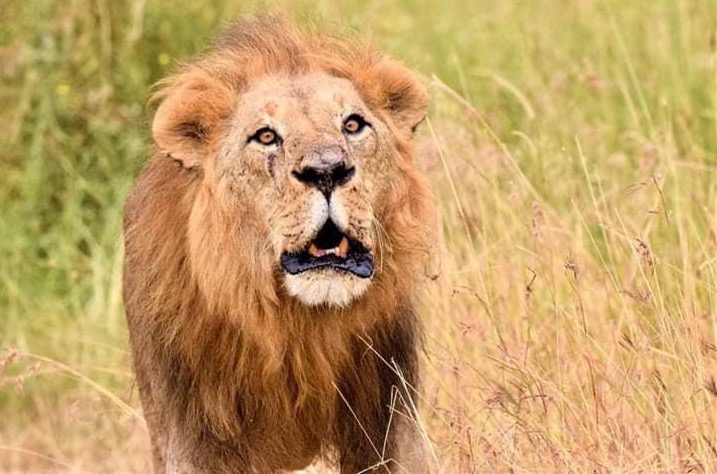
It’s from Arusha town that you will be able to access the Serengeti NP which is the most popular National Park in Tanzania. Each year, thousands and thousands of tourists visits this park annually and nearly all of them together with most wildlife experts agree that the wildlife seen in this park cannot be compared to any other place across the world. several top-notch wildlife documentaries have been shot here such as the ‘African Cats’ by Samuel Jackson and these indeed will give you a brief introduction about the richness of the Serengeti.
According to Safaribookings, the Serengeti National Park is ranked as the best Africa Safari Park and Destination 2019, beating many other renowned African destinations.
History of Serengeti
Over two hundred years ago, the Serengeti plains were discovered by the Maasai pastoralists who migrating in search for fresh pastures and water from Central Africa to Eastern Africa. They were astonished to see such wide plains that were endless – extending mile and miles so they called these lands – ‘‘Siringeti, Siringeti’ to mean ‘the lands that run endlessly’. so with such a humble beginning, this amazing national park received the name Serengeti and today receives more than three hundred thousand visitors a year who come to marvel at its rich wildlife.
Before we introduce you to the animals of the Serengeti, allow me to share with you how these endless plains that had been discovered by the Maasai turned into a National Park.
In the early 1910’s, the Serengeti was visited by an American Conservationist and renowned author Stewart Edward White who spent days exploring these vast plains. When he returned home, he described it as a “beautiful, wide, populous, virgin game country, where no sportsman’s rifle has ever been fired” thanks to the uncountable heads of animals he saw during his stay.
In 1915, Stewart returned with a number of friends for a three months hunting expedition within these vast plains. Sadly in that short time together with his friends, steward had killed a minimum of fifty lions. His actions coupled with the poaching of other local hunters, the number of lions in the Serengeti drastically dropped. The British who at the time were the colonial administrators in Tanzania decided to enclose the entire Serengeti together with the neighboring Ngorongoro, and declared it a game reserve in 1929.
Several years later, the Serengeti obtained a status of National Park in 1951, and today has perhaps the largest population of lions assumed to be close to three thousand individuals. Well having heard all that history about this place, I assume that the one question that is ringing in each and every reader’s mind is:
What Animals are found in Serengeti National Park?
Well, below we bring the top twenty (20) commonest animals found in the renowned Serengeti National Park
-
The Lion –King of the Jungle
One of the most impressive yet pretty humbling wildlife views on a Safari in Africa is seeing the lion – also known as the king of the Jungle, however the ultimate prize of any wildlife adventure is witness a lion make a kill. It is among Africa’s Big Five animals. The Serengeti National park has approximately 3,000 lions living within its boundaries making it one of the most lion populated places in the world. With such a population, it’s no wonder that the vast Savanna of the Serengeti is the best place to see the lion on the African continent. Lions are most active at daybreak and at sunset, and rest for about twenty (20) hours a day. Among the wild cat species, the lions are the most social with prides of 5 to 10 adults. One of the biggest threats to lions especially across the African continent is human encroachment on their natural habitat.
-
The Cheetah – Fastest Land Animal
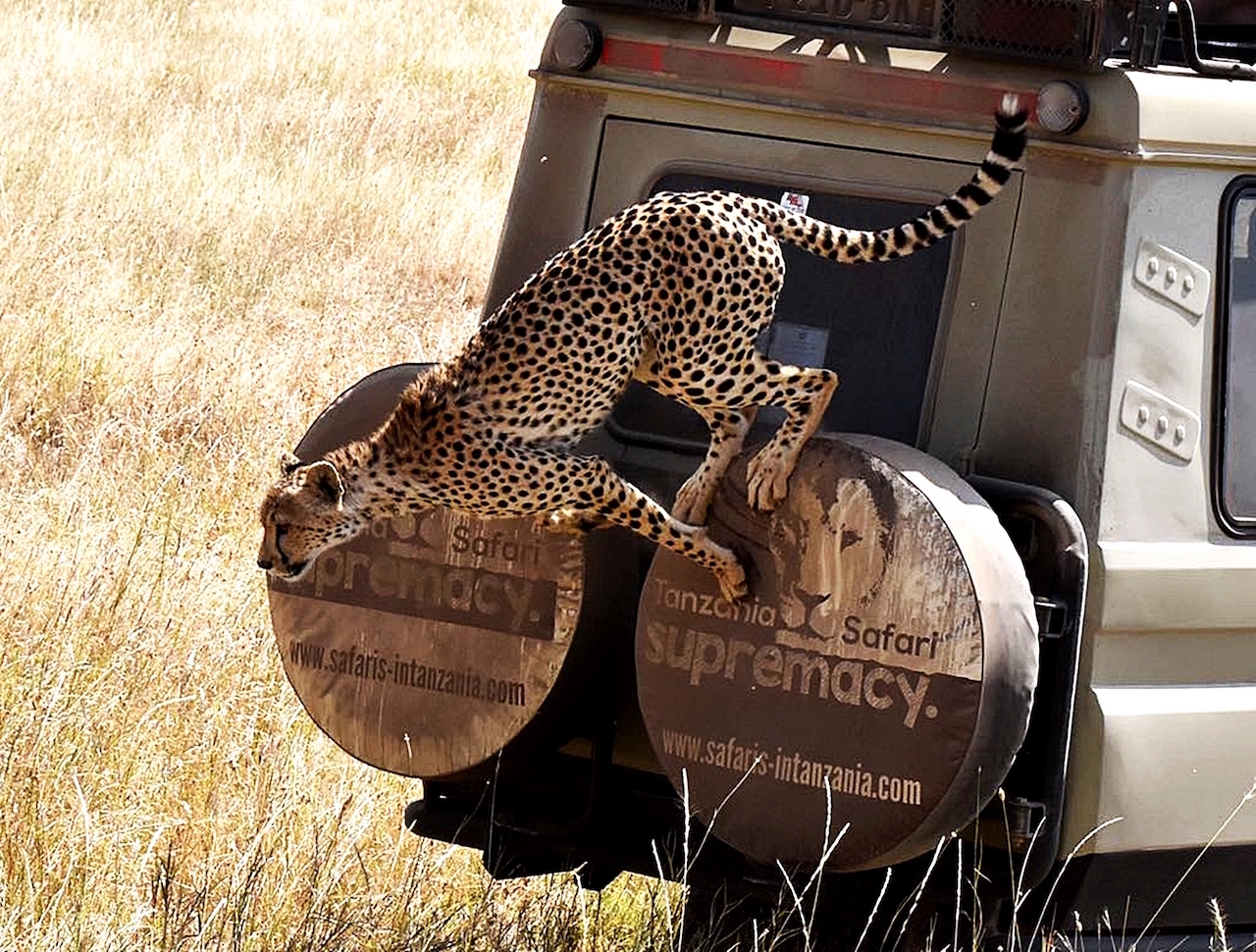
Among the big cat family found in Arica, the cheetah is the most slender of them all. It is remarkably beautiful and known as the fastest land predator on the earth. They can shoot to a speed of 112 km/hr (70 miles per hour). Unfortunately, the stronger predators have a tendency of stealing their catch after making a tremendous hun
t down of their prey. It is estimated that there are about 6,600 cheetahs remaining in the world which makes them a vulnerable species. They normally stay within the open south eastern plains to enable them run to their highest speed which chasing after their prey. special about them is that they are not scared of people unlike other wild cats. many times we have seen and even watched documentaries of cheetahs resting on tourist vehicles.
-
The Leopard – most elusive animal
The Leopards is among Africa’s Big Five animals and it hates any disturbance while enjoying its meal. The leopard is one of the most difficult animals to see because of their elusive nature. They are normally spotted in trees which they not only use as their observation platforms to spot their prey but for protection as well. Leopards are very suspicious of man and are generally solitarily. They have a number of outstanding predatory skills such as swimming; climbing and can drag prey that weighs thrice their size up a tree (normally the sausage trees). They are listed on the IUNC Red List as one of the vulnerable species.
Try your luck to spot these most elusive animals by taking our combined Tanzania safari and Zanzibar packages. Sample a few of the tours that we have listed on our website in that link.
-
The Hyena – laughing predator
These smaller predators with have a characteristic laugh live in groups known as clans that can have between five and eighty (5 to 80) members. The bigger a clan is the more dangerous it is to the extent that it can take down a big ungulate. They work as a team and trust in solidarity. They normally eat after large predators like lions and are best known as scavengers of dead animals. They rank among the biggest predators in Africa coming second to the lion.
-
The Nile Crocodiles – biggest living reptile in the world
The Nile predator is the biggest living reptile in the world, and the largest ever recorded was 6 meters (20 ft) long. They are commonly sunbathing in the shallows of the riverbanks, although they camouflage well in
water. These ancient looking creatures have a very strong jaw and heavily toughened skin, and have been in existence for a very long time. During the months of the wildebeest migration herd crossing River Mara and River Grumeti, the crocodiles put on a very dramatic show as they aggressively attack the zebras and wildebeests trying to cross the river. This event attracts thousands and thousands of tourists into the Serengeti each year as it’s the best place to watch a crocodile make a live hunt!
Check out our sample safari tour itineraries in Tanzania with prices, ith information on what is included and what is not included.
-
The Elephant – largest terrestrial mammal
The elephant is the biggest living terrestrial animal in the world, with an adult male weight up to 7 tones. It is among Africa’s Big Five animals. It is quite an overwhelming experience when you set eyes on such a gigantic moving mass on your Tanzania wildlife safari in Serengeti. Generally they are peaceful animals given that you do not disturb them when in their midst, however, if provoked they charge, and can run pretty fast that you may totally forget about their huge size. Being herbivores, they consume about 450 kilos / 990 pounds of vegetation each day.
-
The African Buffalo – among the most dangerous animals
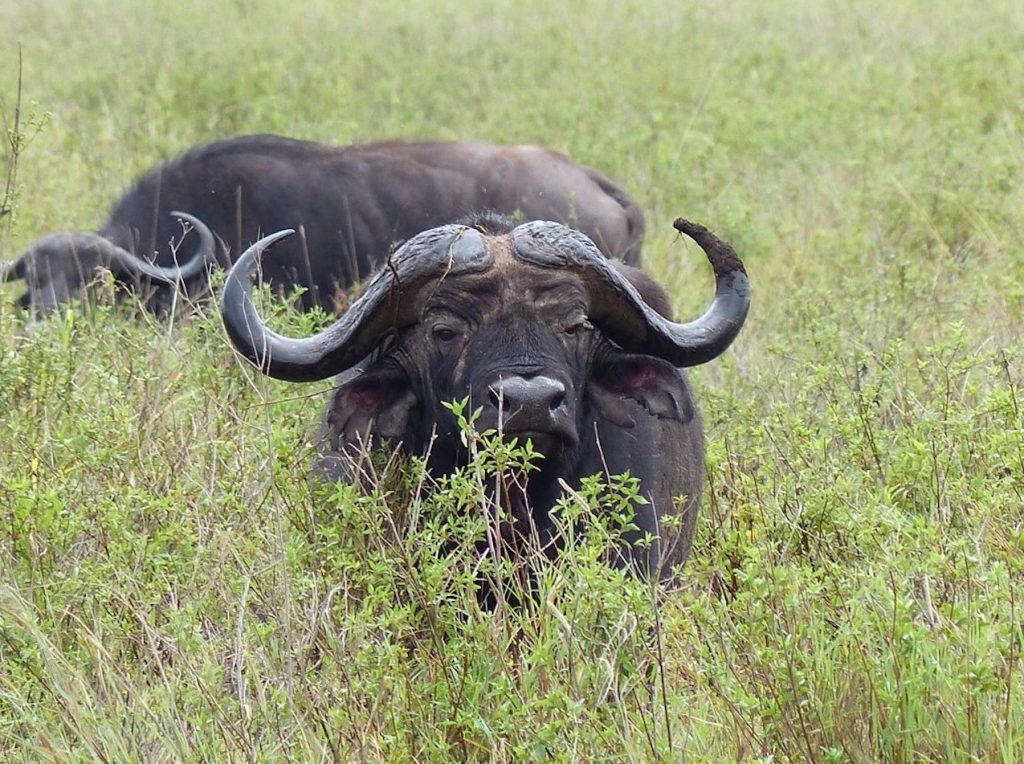
The Buffalo which is among Africa’s Big Five animals has a strong body with uniquely outstanding horns and many may mistake it to be a domestic cow. These large grazers have two major predators: the crocodile and lion, and are normally moving in s
izeable herds. It is a very impressive sight watching a large herd of buffaloes traversing the savanna plains, and unlike other wild buffalo species, because of the unpredictable nature and aggressiveness of the African buffaloes, they have never been successfully domesticated. Across the continent several cases are reported each year of buffaloes injuring man. So you should treat them with respect as they are considered to be one of the most dangerous wild animals. They are commonly seen drinking around waterholes and other water sources because they enjoy drinking.
-
The Rhino – One of the heaviest land mammals
The rhino is one of the heaviest mammals living on land, and an adult male can weigh up to 2,300 kg / 5,100 pounds. It is among Africa’s Big Five animals. These animals which are considered to be an endangered species in Africa are short sighted, give birth once in five (5) years and are normally seen in solitary. It is always recommended to track the Serengeti rhinos led by an experienced because chances of seeing them come with good luck. not so long ago, the most dominant and oldest rhino in the Serengeti known as ‘John’ died and his son ‘Rajab’ took over the ‘dominance’ and reproduction duties and thanks to his clever ‘work’ today there are about one hundred and forty rhinos living in Serengeti. Because of poaching the number of Rhinos in the country had once reduced to very saddening numbers just as it is in most of Africa, however, thanks to the anti-poaching measures that have been put in place and the great Conservation works of the Wildlife Authority in Tanzania in conjunction to other local and international conservation organizations, their number is now rising again to promising numbers. Another place where there is a high chance to spot the Black Rhinos is in the Ngorongoro Crater within the NCAA.
-
Wildebeest
These dominate the wildlife in Serengeti National Park, thanks to their big number. They are very amazing to watch when being chased by predators on land as even in the waters or river Mara. Approximately one and a half million wildebeest live within this park. These ungulates together with zebras and a few gazelles are the main players of the annual Great Migration. You can contact one of our experts for more on how to plan your next Wildebeests migration safari during summer; starting July until October every year or you may also be interested in coming earlier from February to March when we usually have the Wildebeests calving safari in Ndutu Tanzania.
-
The Giraffe – the National Animal of Tanzania
The Serengeti which is home to the Maasai giraffe is one of the best places to see this amazingly tall animal in Africa. The Giraffes prides in being the tallest animal on the entire earth, actually one would assume that because of their towering height, they can easily be spotted on a Tanzania Safari tour. In reality, their brown and white patterns on the coats of their skin act as a very good camouflage despite the fact that they can easily appear in the bushes just a couple of meters from you. They have a strong blue tongue which they use when feeding. On their head is a pair of small protruding horns-like features while their head is supported by a shockingly long neck.
- The Zebra – have best sight among ungulates
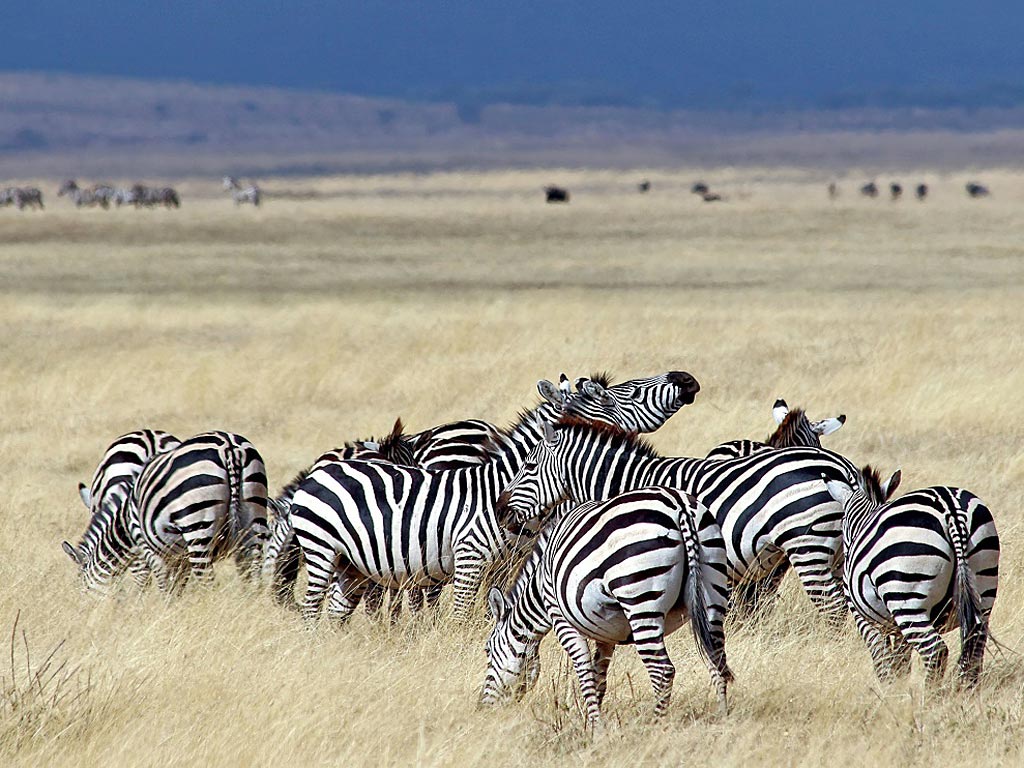
Zebras have a very beautiful blank and white stripe pattern and to some people may appear like domestic horses yet in reality they are not easy to tame. These grazers normally live in large herds that migrate from place to place in search for fresh pastures. As they migrate, they usually form mutually beneficial relationships with other grazers and the best example to illustrate this is during the Annual Wildebeest Migration
that includes thousands and thousands of zebras and wildebeests. During the migration, wildebeests have better hearing capability to easily detect predators’ sounds even miles away, however, the zebra have the extraordinary ability to keep long memory that guides this large herd along their migratory route each passing year. They have a very good sight and are rated to have the best sight among ungulates.
Check out also 15 reasons why you should visit Tanzania for safari.
-
The Hippopotamus / Hippo
The Hippo pool in Serengeti National Park is home to a very large number of hippos. Typically hippos live in groups (schools) of up to 100 individuals, and spend most of their time in water. At nightfall, they leave the water to graze on the banks of the water source. Amazingly, these water lovers have some special adaptations such as: they secrete a unique substance that serves as a sunscreen to their bodies, have webbed feet to help them swim, and have huge canine tusks. The males are territorial and similar to buffaloes, when provoked can turn out to be extremely aggressive. special care should be taken never to go between a calf and its mother buffalo.
-
Colobus Monkeys
The vast plains of Serengeti are known to be home to large numbers of predators, however when you explore the forested areas around river Grumeti, you will be fascinated by the large number of primates living there. Besides olive baboons and the vervet monkeys, the colobus monkeys are the most prevalent primate species. Special about these is that they lack thumbs and have a unique color of coats on their body. They are herbivore feeding on tree backs, flowers, leaves and fruits.
-
The Impala
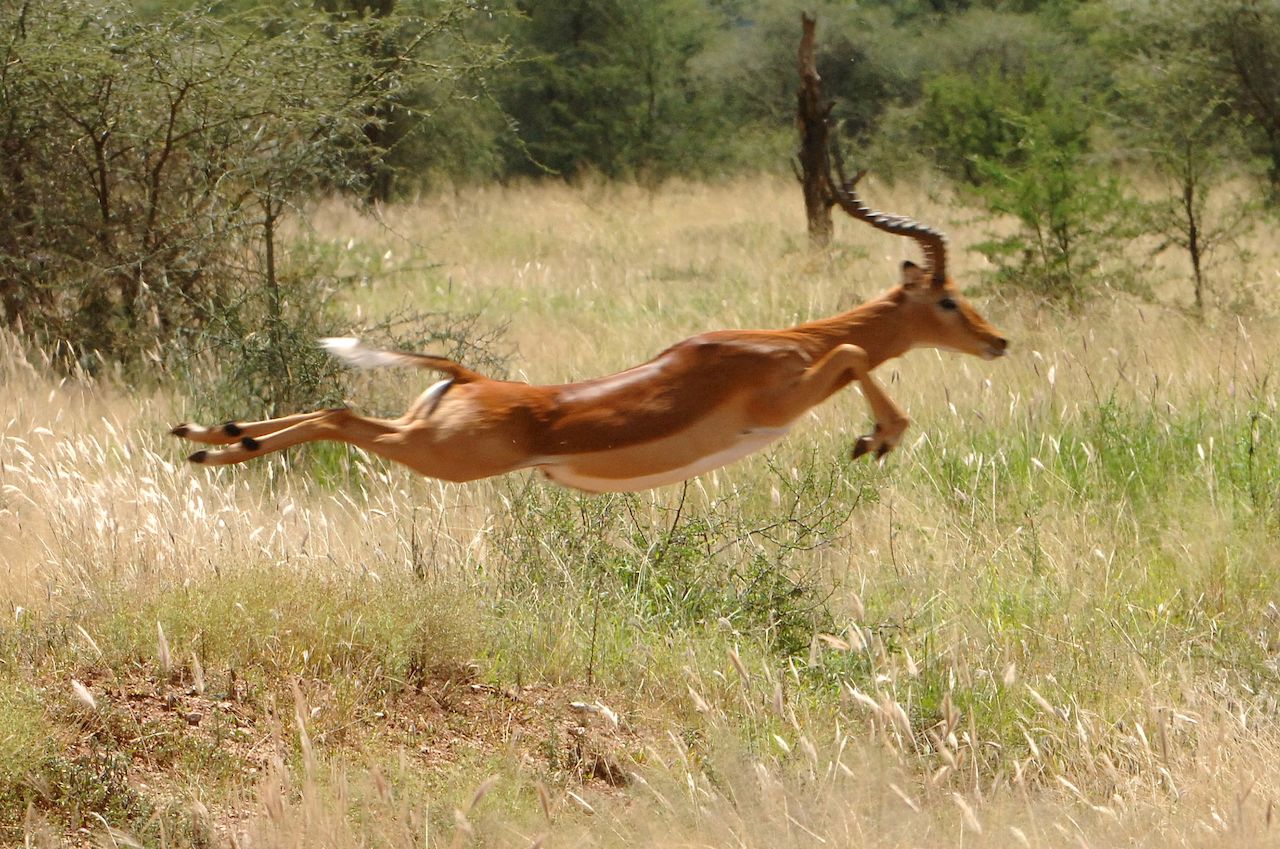
These are another very a
ctive grazer living within the Serengeti. They are medium sized and an adult male can weigh up to seventy five (75) kilograms. It is among the fastest sprinting animals who do so in a very impressive way. When running, they can jump to height of nine meters (9m) above the ground, and cover a total of ten meters (10m) in a single leap. During their jumps, they sometimes go over other impalas especially if running in a herd.
-
The Topi
The topi are among the other animals that usually follow the popularly known annual migratory herd of wildebeests and zebras. This species of antelope can weigh up to one hundred and forty five kilograms (145 kg) and have an overall lifespan of fifteen (15) years. Tanzania has one of the largest populations of topi across the African continent however for the best views of this amazing species; consider taking a safari in the Serengeti. They have a number of unique adaptations that enable them to survive in the predator infested plains of the Serengeti and these include: sharp hearing and good sight.
-
The Rock Hyrax – elephants’ closest living cousins
The rock Hyrax is the closest living relative the giant elephant. If this was a question ask, I am sure many people would come up with answers like buffalo or rhino which are actual far away from the truth. Well these amazing small creatures which in fact do not look like the elephant to begin with in size, are some of the animals you will be able to encounter on your Tanzania safari in Serengeti. The elephant and hyrax share a common ancestor known as Tethytheria, said to have died several million years ago. These two animals share a number of similarities such as common features on their reproductive parks and devel
opment of the task from their incisor teeth.
-
The Gazelle
The gazelles are a delicacy to the Cheetahs. Despite the fact that they are fast runners, the gazelles are normally hunted down by cheetahs which because of their small size not only make the best prey but enough to feed a family of cheetahs. Because of their large number, you might b fortunate enough to witness a gazelle sprinting to save its life from a hungry predator. Because of extensive hunting, and human encroachment on their natural habitat, the Gazelles have severely reduced in number and today it is estimated that there are less than 2,500 of them surviving in their natural habitat across the world.
-
The Defassa Waterbuck – the handsome antelope
This is among the largest species of the antelope family and an adult male can weigh to over two hundred and forty kilograms (240 km). This is a very handsome antelope. They are grazer and a very fascinating

animal to see on your safari. Waterbucks have brown gray coats with shaggy long hair that secrete an oily emission from their sweat gland that serves as a water repellent. Generally, the males are 25% bigger than the females, and it’s the males that have ringed horns that curve beautifully and are widely spaced which can grow as long as 40 inches (100cm).
-
Hartebeest
The number of hartebeests living within the Serengeti National Park is very impressive. These animals which are locally referred to as the ‘Kongoni’ live in herds of up to 300 members with about twenty adults. They have a lifespan of fifteen (15) years. They use their dreadful horn if attached and use their long legs to run to safety. Tanzania stands out among the African countries as having one of the largest populations of hartebeest and these can best be seen in the Serengeti.
-
The Dik-dik
The Dik-Dik grows to a height of 30 meters to 40 meters and has a lifespan of ten (10) years. These cannot easily be seen within the open plains of the savanna however during your game drive you may be lucky enough to sight a leopard feasting on one up in the tree branches.
See you on your next Serengeti Safari tour or a combined tour of Serengeti safari and Zanzibar tour, where you will have the chance of seeing many animals and birds including most of those that are listed on this list of animals in Serengeti National Park.

Comments